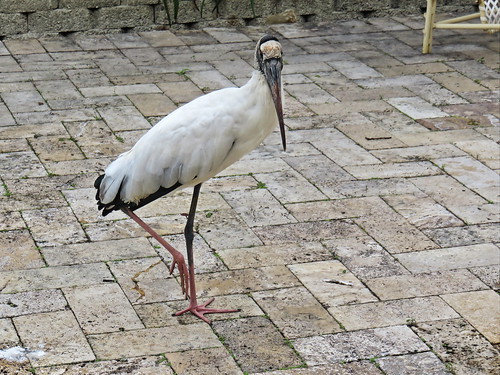
The recent visitor was an immature bird, as evidenced by the light yellowish or bone color of its bill. By the time they are three years old, adults have developed black bills. It was probably a second-year bird, as those which hatched out this year would retain some feathers on their heads and their bills would be brighter yellow. It walked along the lake shore just off our patio:

In typical fashion it stirred the water with its pink foot to frighten fish into its waiting open jaws:
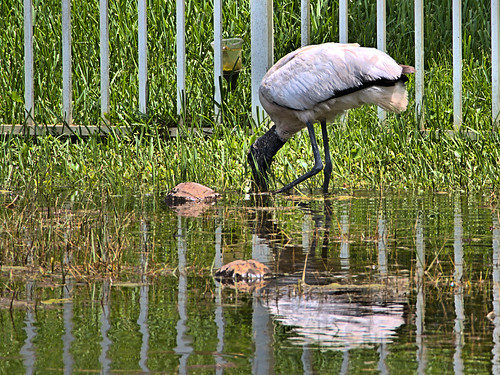
A Tricolored Heron scurried about as it fished along the lake:
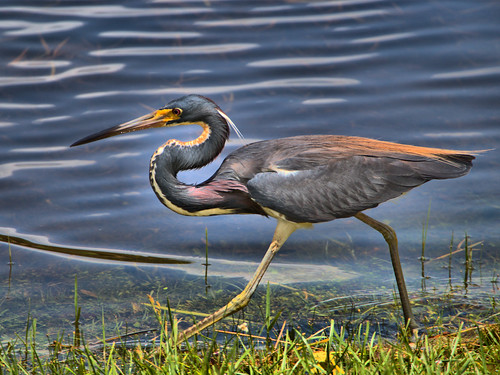
Unlike the stork, which is a patient tactile feeder who waits for the prey to approach its jaws, the heron uses its keen eyesight to spot and pursue anything edible. It caught a small fish along with a dead leaf and carried both up onto our lawn. This prevented the fish from escaping into the water as the heron used its tongue to dislodge the vegetable matter:

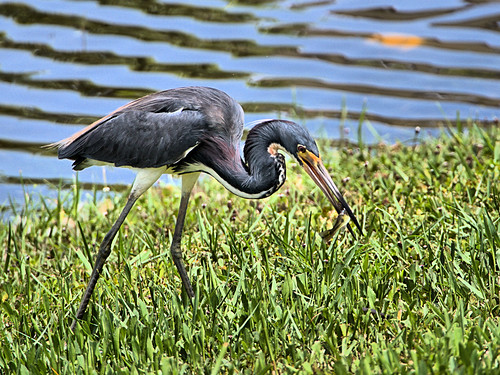
The heron joined the stork in a quiet corner of the lake where floating coconuts had accumulated. (Some have sprouted into trees which will eventually be removed by the landscapers.) We often see such associations between sight and tactile feeders, as this can be mutually beneficial. The heron helps the stork find schools of fish. The stork then scatters them out into open water. Note the maturing mangoes on a neighbor's tree:

The stork extends one wing while stirring the water with the opposite foot. I used to think they were doing this to cut down on glare so that they could see the fish, but they don't catch by sight. Rather, the fish tend to collect in the shade of the wing, making them more likely to stray into the stork's waiting jaws:

A Great Egret fished nearby. The fence and red walls of a neighbor's house reflected nicely:

A Blue Jay roosted on our mango tree. Our fruit ripened much earlier this year:

We left the topmost mangoes to the wildlife. Egyptian Geese savored them:

Out in the local wetlands, mosquitoes descended in hordes. Among them was a very large species with a painful bite, the American Giant Mosquito (Psorophora ciliata), sometimes called Shaggy-legged Gallinipper or Feather-legged Gallinipper. Indeed, it has banded shaggy legs and looks like a wasp. It appears sometimes after a spell of heavy rain but is not known to carry any human diseases:
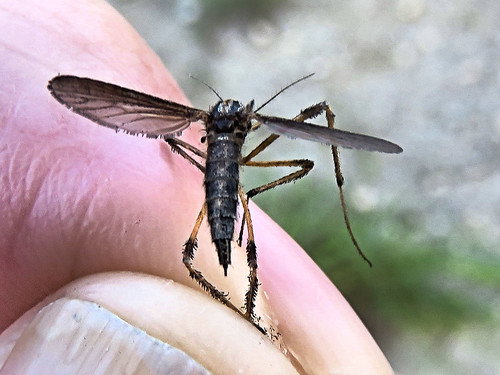
As usual, we go out early. Here is MaryLou up ahead of me with her flashlight, under the full Strawberry Moon:
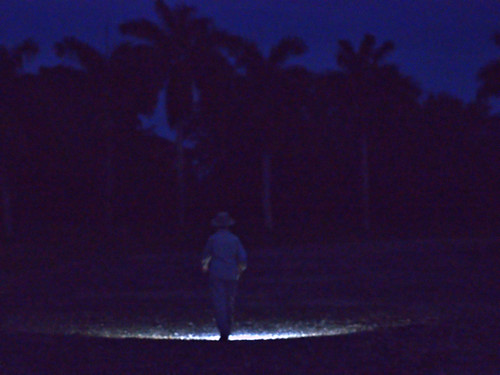

Sunlight touched the Wet Prairie through morning haze, dust blown in from Africa:
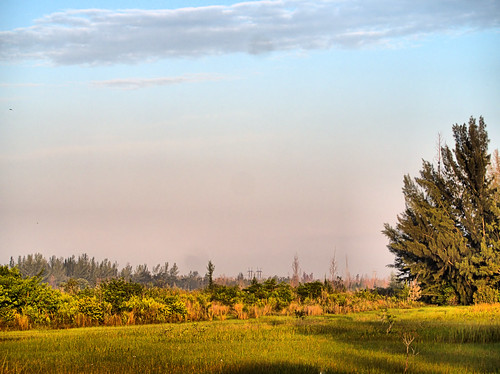
Back at my computer I discovered that one of my views revealed a distant deer:

Anti-solar rays opposite the sunrise, reflecting the Saharan dust, converged on the western horizon, creating a mirrored or false sunrise:
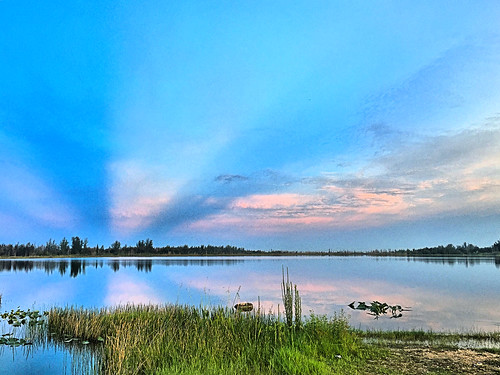
Recently cleared of debris left almost two years ago by Hurricane Irma, the levee trail was inviting:

A Marsh Rabbit appeared on the track:

Ahead, a female White-tailed Deer checked to see if it was safe to cross. I slowly raised my camera:

The doe led her half-grown fawn across the trail:

A buck, its growing antlers still in velvet, followed close behind:

I knew where the deer were most likely headed, so I crept over to get an open shot. The buck spotted me first:
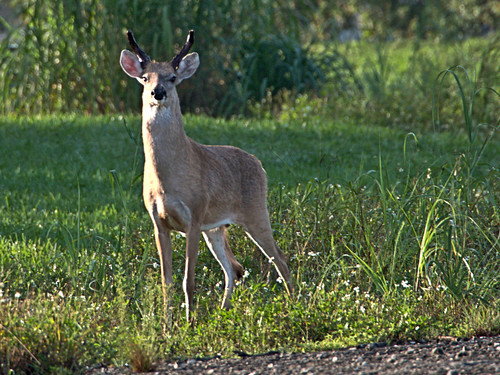
The fawn emerged from cover and trotted right past me:

Sensing danger, the doe raised her tail like a flag and then bounded after her offspring:

The buck followed, and their hoof-beats rattled on the gravel track:

A Mourning Dove basked in the sun:

Storm clouds gathered:
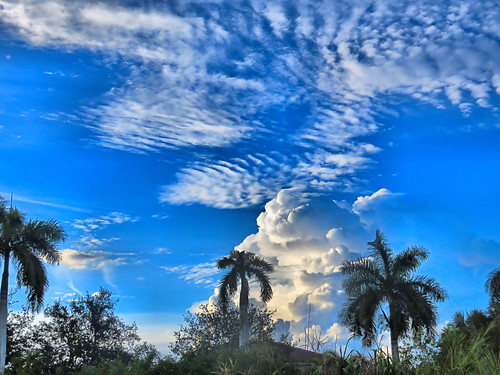
= = = = = = = = = = = = = = =
Linking to Misty's CAMERA CRITTERS,
Linking to Eileen's SATURDAY'S CRITTERS,
Linking to SKYWATCH FRIDAY by Yogi, Sylvia and Sandy
Linking to WEEKEND REFLECTIONS by James
Linking to BirdD'Pot by Anni
Linking to Our World Tuesday by Lady Fi
Linking to Wild Bird Wednesday by Stewart
Linking to Wordless Wednesday (on Tuesday) by NC Sue
Linking to ALL SEASONS by Jesh
Linking to Fences Around the World by Gosia
________________________________________________
Please visit the links to all these memes to see some excellent photos on display
________________________________________________
so many nice catches here.
ReplyDeleteI noticed, a year after clicking my Labrador in the river, that I had caught a fish leaping from the water
Excellent shots. Shaggy-legged Gallinipper is a good name.
ReplyDeleteI would love to see any of those birds or animals in our back yard. Minus the bunny and the mosquito!!! Interesting photos. Have a great weekend, Diane
ReplyDeleteHaving a Wood Stork on your back patio must have been quite a sight! I like the shot of Mary Lou walking in the dark with a flash light. Beautiful skywatch shot!
ReplyDeleteFabulous bird shots. Awesome.
ReplyDeleteWorth a Thousand Words
your nature is amaziong love from Katowice Poland
ReplyDeleteYour photos are always so gorgeous - I love taking a stroll with you.
ReplyDeleteA gripping post. I feel as if I've been taken on a walk I will never tread and seen creatures I will never see in real life. Fascinating.
ReplyDeleteGrandiose Fotos !
ReplyDeleteMy contribution:
https://meinmitmach.blogspot.com/2019/06/hoverflies-schwebefliegen.html
Beautiful shots.
ReplyDeleteHello Ken, beautiful sky scenes. I love the deer and bunny. Great sighting of the Wood Stork and Tricolored Heron. I like the photo with the two together. I have not seen the Egyptian Goose yet, maybe in a zoo. Great series of photos and lovely birds. Thank you for linking up and sharing your post. Happy Saturday, enjoy your weekend. Thanks also for leaving me a comment.
ReplyDeleteI love your new banner! And how neat to see the deer when you looked at your photos! The Stork looks huge next to the Heron! WOW! Great sightings. We hiked this morning and it sure felt great! We don't get out every day in the summer months. Enjoy your weekend!
ReplyDeleteLove the comparison in size of the stork/tri-color. Awesome...right place at the right time. It's been over 2 yrs. since I last saw an E. goose. And your stork visit reminds me to go out in search for them here...that time of year. Thanks for linking up with us.
ReplyDeleteCant be to many garden lists that include wood stork! Great set of pictures - really like the deer.
ReplyDeleteStewart M - (finally back in) Melbourne
Beautiful photos of your part of the world. I love the S-shaped neck of the tri-colored heron, and your capture of sun rays is magnificent. Nice description, too. Thank you for sharing.
ReplyDeleteMy post features Silver Falls and Grove of the Patriarchs at Mount Rainier
I loved your explanation of the different fishing habits of the stork and the egret. Animals are amazing is all I say, and very sophisticated. I loved the raising the wing to lure fish out into the shadow.
ReplyDeleteGreat photos of the deer. I never tire of seeing deer in the wild.
I like the marsh rabbit - short ears for the cold?
ReplyDeleteAlways wondered what a strawberry moon was - now I know:) The wood stork has the "face" of something/someone out of a mystery movie! The tri-colors heron is so elegant and beautiful. The Egyptian geese looks very different - beautiful! Great shots from the deer - here, they are moseying along, because they are used to the locals who live here.
ReplyDeleteThank you for persevering with the linky for All Seasons - this has been a crazy year for several linky Lists! Have a great rest of the week!
Wonderful photos as usual, but I've got to say the mosquito is my least favorite. Skeeters smell me from miles away. If only one person in a crowd winds up covered with mosquito bites, it's me!
ReplyDeleteThanks for sharing at https://image-in-ing.blogspot.com/2019/07/color-guard.html
@Lydia C Lee-- I have not learned why Marsh Rabbits have such short ears. Since they take to water readily they probably do not rely on them for cooling. I have seen them hiding underwater just below the surface with their ears pressed down against their body and only their nose and eyes above water. Maybe short ears offer less resistance when they swim away from predators, perhaps advantageous to survival. They also have very sparse fur and are adapted to a hot environment.
ReplyDeleteWhat fabulous visitors and sundry critters! Thanks for the info about the stork's eating habits. It's always fun to discover things you didn't know you captured!
ReplyDeleteMy Corner of the World